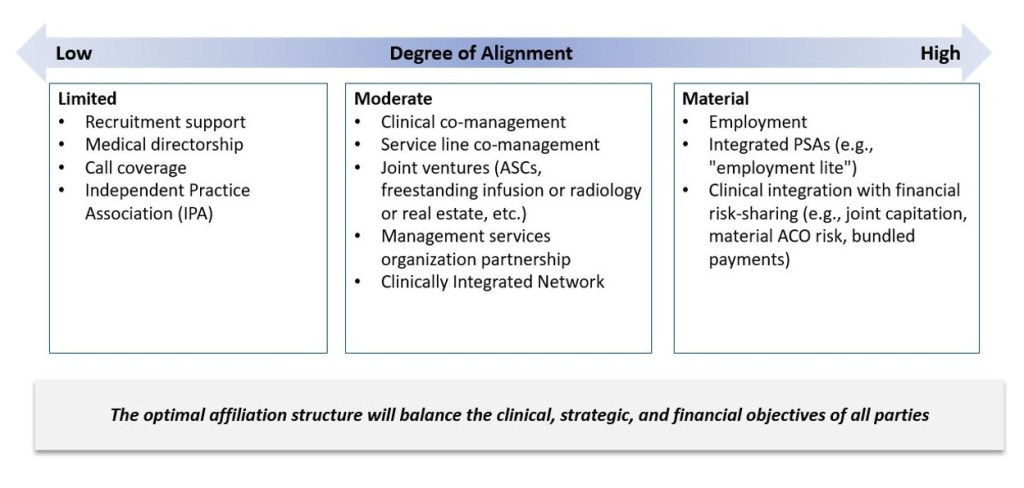Time to take a fresh look at affiliation options for physicians and health systems
As the healthcare marketplace continues to evolve, posing new challenges and creating new opportunities, so too will affiliation models continue evolve in ways that can best meet current and future needs of healthcare providers.
In this environment, health systems and physician practices — both independent and employed — could benefit from taking a fresh look at their affiliation options.
Health systems adopting a physician employment model. Many health systems, responding in part to a competitive threat from an unprecedented array of investors in physician practices, have pursued an employment strategy. Employment promises tighter alignment with physicians, but it has come at a cost, which has been aggravated in recent months by rising labor and supply expenses. Data from Kaufman Hall’s Physician Flash Report indicates that the average investment (or subsidy) per physician FTE climbed from $224,165 in Q3 2020 to $306,404 in Q2 2022.
Physicians accepting employment by health systems. Employed physicians enjoy greater income stability but give up autonomy over operational decision-making. They also might worry that they are missing out on some of the affiliation options and financial opportunities currently available in the marketplace to their independent colleagues.
Physicians maintaining independence. For independent physicians, the potential financial upside of a private-equity investment, for example, may be balanced against concerns over the duration of the partnership or the long-term viability of new care delivery models that have not yet been fully proven. Affiliation with a health system might offer a longer-term relationship and, depending on the degree of alignment, still allow opportunities to experiment or pilot initiatives with other partners.
Finding the best fit
For all parties, the starting point in rethinking their affiliation strategy is a series of questions:
- What do I want an affiliation to achieve?
- Are our current affiliation arrangements aligned with these goals?
- Are there affiliation models that would better serve these goals?
The exhibit below outlines a range of affiliation models along a continuum from a lower to higher degree of alignment.
Physician affiliation model continuum

Many of these models involve two-party affiliations, but several may involve additional parties (e.g., a private-equity investor in a joint venture or a health plan partner in a risk-sharing clinical integration model):
- Models with a lower degree of alignment would be appropriate if, for example, physician autonomy is a high priority, the parties wish to pilot or experiment with an affiliation while keeping other options open, or they want to pursue a less capital-intensive affiliation model.
- Moving to the right on the continuum, capital requirements will usually increase for one or more of the parties, while physician autonomy will decrease under shared governance or ownership structures. Parties may perceive new risks as well, as tightly aligned structures are more difficult to unwind and heightened capital investments increase business risk.
- Moderate and material alignment models can, however, increase the possibility of financial returns (in, for example, a joint venture or risk-sharing model) or financial stability (in an employment model), especially for physician partners. Tighter financial and clinical alignment can also improve contracting opportunities for all parties by creating a broad, integrated network for payer-provider partnerships or direct-to-employer initiatives.
Considerations for creating or rethinking an affiliation
For each party, answers to the questions regarding best fit will help locate their starting point on the physician affiliation model continuum. Because it is unlikely that all parties to a current or potential affiliation will find that their answers are in perfect alignment, arriving at the optimal model that balances the objectives of all parties might require some movement up or down the continuum from that starting point.
Finding the optimal affiliation structure requires an understanding of the parties’ differences as well as their points of agreement.
The differences will be the primary focus of negotiations. Before parties begin the negotiation process, they should know where they are willing to compromise and where they are not. They should also understand that the complexity of negotiations will not always track the degree of alignment; it can be more difficult to negotiate a joint venture agreement with moderate alignment that satisfies all parties, for example, than to execute the sale of a physician practice to pursue an employment model of affiliation with a high degree of alignment.
The most sensitive negotiations likely will be around current affiliations that are not meeting the needs of one or more of the parties. Often with affiliations between health systems and physician practices, both parties will want to continue their relationship even if the current affiliation is not fully meeting the parties’ goals. If the desire to change the nature of the current affiliation is not mutual, the party seeking the change should be ready to make a clear and objective case of why the affiliation is not working and — assuming a continued relationship is desirable — have one or more alternative affiliation models to propose to the other party, along with an explanation of why these alternatives would be preferable. If the parties cannot agree upon an alternative, they will have to decide whether it is better to remain with the existing structure or to part ways.
Conclusion: Adapting to an evolving marketplace
The healthcare marketplace has undergone profound changes in recent years, and for health systems and physicians, those changes offer a good reason to reassess existing affiliation strategies to make sure they can fully meet current and future needs. This opportunity is not just for the few, however. Now is a good time for all health systems and physicians to take a fresh look at their affiliation needs and strategy.






